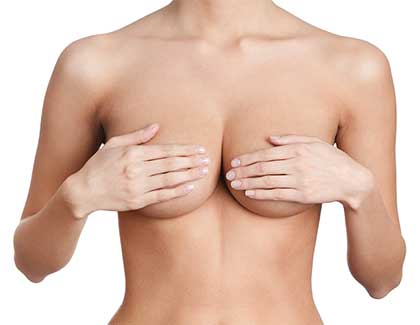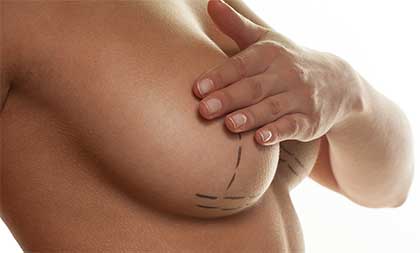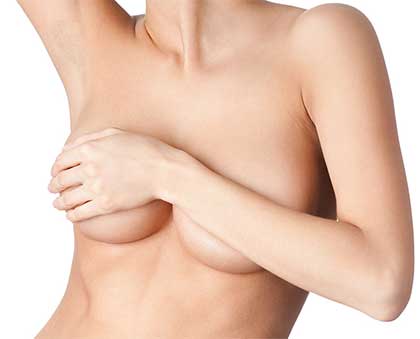Breast augmentation or augmentation mammoplasty
Aesthetic breast surgery, particularly breast augmentation, is the most popular type of surgery in this field.
Augmentation mammoplasty is the surgical technique used to increase breast volume and shape.
Who is it for?
This kind of surgery is indicated for women who consider that their natural breast size does not fit their ideal of beauty.
It is also indicated in patients with breast asymmetries or in women who wish to recover lost volume secondary to pregnancy, lactation, weight loss or age.
The most widely used technique involves the placement of implants (prostheses). However, it is also possible to use the patient's own adipose tissue (breast lipotransfer or lipofilling).
Choice of prosthesis
Careful evaluation is required of each individual case in order to decide the size and shape of the prosthesis, as well as the best placement route in each case, in line with the personal preferences of the patient.
In deciding the size of the prosthesis, consideration is required of the dimensions of the patient, her physical constitution and skin quality.
The three most important parameters are the width of the prosthesis, the height at which it is going to be placed, and the projection desired by the patient, i.e., the degree to which it is to project outwards from the chest.
The surgeon tests different types and sizes of prostheses both in the consulting room and in the operating room, before making the final decision.
Choice of entry and placement route
The surgeon evaluates the entry route that will afford the best aesthetic results according to the breast involved.
The periareolar route has been the most widely recommended option. However, when allowed by the characteristics of the breast, it is increasingly common to use the sub-mammary route, since the scar tends to be hidden by the drop of the breast after surgery.
Likewise, the surgeon must choose the location of the implant, i.e., submuscular (retropectoral), subfascial or subglandular (beneath the gland itself). The most common practice is retropectoral placement of the implant, beneath the greater pectoral muscle (pectoralis major).
Guaranteed prostheses
The prostheses we use in Artemédica always meet all the maximum quality controls.

Breast reduction
Reduction mammoplasty is performed to reduce the size of the breast and thus its weight, adapting it to the aesthetic and functional needs of the patient.
Who is it for?
This type of surgery is indicated for women with an excessive breast volume that is disproportionate with her body.
It is not exclusive of obese patients. Breast hypertrophy can be found in both overweight and thin patients.
Although in most cases breast reduction is done for aesthetic reasons, in some situations it is indicated for medical problems. In patients with an excessive breast size (gigantomastia), the weight of the breasts can give rise to back pain, neck pain, headache, dermatitis of the submammary fold, and even breathing problems.
Choosing the adequate size
In the same way as in breast augmentation surgery, in deciding the magnitude of reduction, consideration is required of the dimensions of the patient and her physical constitution, preserving the natural proportions of her body.

Mastopexy or breast lift

Mastopexy or breast lift surgery seeks to counter sagging of the breast (breast ptosis).
When
Sagging of the breast may be a natural condition or can result from age, excessive exercise without adequate breast support, pregnancy or major weight loss.
Sagging is not dependent on breast size and can occur with both large and small breasts.
With or without implants
Depending on the anatomy of the breast and the desires of the patient, mastopexy can be performed with or without implant placement.
If there is enough breast tissue and the patient does not want an increase in breast volume, the reconstruction procedure can be carried out without implant placement.
In contrast, if the breast is somewhat vacant and/or the patient wants an increase in size, a silicone prosthesis is placed in the process.
In either case the operation can be completed by adding autologous adipose tissue.
Aesthetic surgery of the areola and nipple
Such surgery is indicated in cases where the shape of the areola or nipple is irregular, giving rise to discomfort such as for example a hypertrophic nipple, or causes aesthetic concerns (e.g., nipple inversion).
Correction of breast asymmetries
This is indicated when one breast is larger or quite different from the other, and this causes problems for the patient.
Depending on the case, surgery may be decided, though normally the solution is augmentation of the smaller size breast.
Gynecomastia in males
Gynecomastia is breast enlargement in males as a consequence of an increase in adipose tissue and glandular component.
Pseudo-gynecomastia is breast enlargement in males only a consequence of an increase in adipose tissue.
Gynecomastia can be caused by certain diseases characterized by hormone alterations, such as medications, or by genetic predisposition.
Pseudo-gynecomastia in turn tends to appear in situations of obesity and sometimes as a result of aging.
Surgery
Surgery seeks to restore a flat and firm chest in the male patient similar to that found before the causal alteration.
The correction of gynecomastia involves the removal of adipose tissue with or without the resection of gland tissue, depending on the case.
In some cases, skin must also be removed, followed by reconstruction.
The postoperative period is uneventful, with minimum discomfort, and recovery is excellent - particularly with physiotherapy techniques such as lymphatic drainage.

Breast reconstruction

Breast reconstruction surgery is carried out after mastectomy or other surgical techniques used in malignant breast disease and seeks to restore patient body harmony and thus self-esteem, which undoubtedly contributes to improve the prognosis.
When
Breast reconstruction surgery can be performed at the time of mastectomy (immediate reconstruction) or can be postponed for weeks, months or even years. It is never late to try to feel better.
Types of surgery
There are many available surgical techniques, and the choice depends on the kind of surgery performed to treat the previous problem.
Reconstruction with implants
The most widely used reconstruction technique involves the placement of a breast implant.
In most of these cases an expander first must be placed to increase the elasticity of the skin and facilitate housing of the implant. The expander is a temporary implant that is gradually filled with saline solution in the consulting room, until the desired size has been reached.
Once in the operating room, the expander is replaced by the definitive implant.
Lipofilling
This technique consists of filling the breast space with the patient's own adipose tissue previously harvested from another zone.
It is usually used in cases where the required volume is not very large and very natural results are desired.
It is sometimes carried out as a complement to other surgeries.
Lipofilling is also used to correct asymmetries and for remodelling of the breast. It can be performed to increase volume in a breast that already has an implant and in which implant replacement is not desired, or for filling palpable margins or some folds in the prosthesis.
Contralateral breast symmetry surgery
There are different techniques for application to the remaining breast in which the aim is to even the shape and size of both breasts.
Reconstruction of the nipple and areola
In most cases, at the end of the process, reconstruction of the nipple and areola is required. Where possible, this is usually done with skin from the contralateral breast.
Areola micropigmentation
This constitutes the last step in breast reconstruction.
This technique involves the introduction of micropigments in the dermis, resulting in a very natural breast appearance.
In contrast to the ink used in tattoos, these micropigments fade over time, and so subsequent adjustments are usually needed.
Breast contouring
Tuberous breast
There are breast malformations that can be corrected through surgery.
One of the most frequent presentations is tuberous breast, thus known due to its tubular shape.
Causes
The underlying causes are not fully clear, though it appears to be a development defect of the breast during its formation and growth in adolescence. The breast only grows forward from a small implantation base, resulting in a tubular or cone shape rather than a rounded morphology.
The breasts tend to be small, separated far apart, with an areola disproportionately large for the size of the breast, and often with asymmetries. In some cases the anomaly only affects one breast.
Surgery
The success of corrective surgery begins with a good diagnosis.
Surgery aims to correct the tubular shape, increase breast volume, modify the appearance of the areola and sometimes lift the breast.
In most cases the patient comes to the clinic only because she feels that her breasts are small and wishes to have an increase in size. If adequate anatomical correction is not made before volume augmentation, the aesthetic outcome will be poor.
Breast asymmetry or anisomastia
The term anisomastia refers to an unequal size and/or shape of the breasts.
Causes
The condition may be due to unequal development of the two breasts; alternatively, it may be a consequence of some disease, pregnancy or surgical procedure (generally in breast cancer).
Most women naturally present discrete breast asymmetry which they are practically unaware of, and which does not affect their self-perception in any way.
However, when asymmetry is more evident, it almost always affects patient self-esteem, with a negative impact upon social and sexual relations.
Solutions
Depending on the cause, the degree of asymmetry and particularly on whether there is some kind of associated malformation, the surgical technique will differ in adaptation to each individual case.
We can use lifting, reduction or augmentation of the breast, with an implant or autologous adipose tissue, or a combination of these.

Second surgeries

If you don't like the result.
In some cases, an operated breast requires surgery again. There may be a number of reasons for this, but one of the most common is poorly done surgery, with an undesired aesthetic outcome.
Replacement of the prosthesis
In some cases, the prosthesis ages and needs to be replaced, as occurs for example in the case of smooth implants that are more than 10 years old. Aged implants present physical alterations such as folds (rippling) that interfere with its function and increase the probability of rupture.
Implant rupture inevitably requires replacement.
In some cases, the patient wishes to change the size to a larger or a smaller implant.
Changing the anatomical plane of implant placement may also be decided.
Replacement may be considered when the implant displaces downwards and lifting of the breast, or the implant proves necessary.
Another possible scenario is when the implant has become encapsulated.
Lastly, replacement may be decided simply when the previously chosen implant did not have the adequate shape and/or quality, or surgery was not well done.
Removal of the prosthesis
In exceptional cases, some women over time decide they no longer want the breast implants.
The surgery in this case is simple and basically consists of extraction of the prostheses.
In such situations we usually recommend filling with the patient's own adipose tissue in order to avoid excessive breast flaccidity.
Artemedica, aesthetic and reconstructive plastic surgery center in Murcia, Spain.
Access the medical services you need, with the best specialists and the maximum guarantee.




